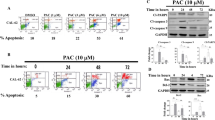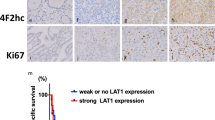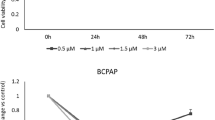Abstract
To develop novel therapies for aggressive thyroid cancers, we have synthesized a collection of histone deacetylase (HDAC) inhibitor analogs named AB1 to AB13, which have different linkers between a metal chelating group and a hydrophobic cap. The purpose of this study was to screen out the most effective compounds and evaluate the therapeutic efficacy. AB2, AB3 and AB10 demonstrated the lowest half-maximal inhibitory concentration (IC50) values in one metastatic follicular and two anaplastic thyroid cancer cell lines. Treatment with each of the three ABs resulted in an increase in apoptosis markers, including cleaved poly adenosine diphosphate ribose polymerase (PARP) and cleaved caspase 3. Additionally, the expression of cell-cycle regulatory proteins p21WAF1 and p27Kip1 increased with the treatment of ABs while cyclin D1 decreased. Furthermore, AB2, AB3 and AB10 were able to induce thyrocyte-specific genes in the three thyroid cancer cell lines indicated by increased expression levels of sodium iodide symporter, paired box gene 8, thyroid transcription factor 1 (TTF1), TTF2 and thyroid-stimulating hormone receptors. AB2, AB3 and AB10 suppress thyroid cancer cell growth via cell-cycle arrest and apoptosis. They also induce cell re-differentiation, which could make aggressive cancer cells more susceptible to radioactive iodine therapy.
This is a preview of subscription content, access via your institution
Access options
Subscribe to this journal
Receive 12 print issues and online access
$259.00 per year
only $21.58 per issue
Buy this article
- Purchase on Springer Link
- Instant access to full article PDF
Prices may be subject to local taxes which are calculated during checkout





Similar content being viewed by others
References
Siegel R, Ma J, Zou Z, Jemal A . Cancer statistics, 2014. CA Cancer J Clin 2014; 64: 9–29.
Zidan J, Karen D, Stein M, Rosenblatt E, Basher W, Kuten A . Pure versus follicular variant of papillary thyroid carcinoma: clinical features, prognostic factors, treatment, and survival. Cancer 2003; 97: 1181–1185.
Hsu KT, Yu XM, Audhya AW, Jaume JC, Lloyd RV, Miyamoto S et al. Novel approaches in anaplastic thyroid cancer therapy. Oncologist 2014; 19: 1148–1155.
Wein RO, Weber RS . Anaplastic thyroid carcinoma: palliation or treatment? Curr Opin Otolaryngol Head Neck Surg 2011; 19: 113–118.
Ford D, Giridharan S, McConkey C, Hartley A, Brammer C, Watkinson JC et al. External beam radiotherapy in the management of differentiated thyroid cancer. Clin Oncol (R Coll Radiol) 2003; 15: 337–341.
Mazzaferri EL, Jhiang SM . Differentiated thyroid cancer long-term impact of initial therapy. Trans Am Clin Climatol Assoc 1995; 106: 151–168 discussion 168-170.
Marks P, Rifkind RA, Richon VM, Breslow R, Miller T, Kelly WK . Histone deacetylases and cancer: causes and therapies. Nat Rev Cancer 2001; 1: 194–202.
Kelly WK, Marks PA . Drug insight: Histone deacetylase inhibitors—development of the new targeted anticancer agent suberoylanilide hydroxamic acid. Nat Clin Pract Oncol 2005; 2: 150–157.
Minucci S, Pelicci PG . Histone deacetylase inhibitors and the promise of epigenetic (and more) treatments for cancer. Nat Rev Cancer 2006; 6: 38–51.
Santini V, Gozzini A, Ferrari G . Histone deacetylase inhibitors: molecular and biological activity as a premise to clinical application. Curr Drug Metab 2007; 8: 383–393.
Marks PA, Richon VM, Rifkind RA . Histone deacetylase inhibitors: inducers of differentiation or apoptosis of transformed cells. J Natl Cancer Inst 2000; 92: 1210–1216.
Mitsiades CS, Poulaki V, McMullan C, Negri J, Fanourakis G, Goudopoulou A et al. Novel histone deacetylase inhibitors in the treatment of thyroid cancer. Clin Cancer Res 2005; 11: 3958–3965.
Weinlander E, Somnay Y, Harrison AD, Wang C, Cheng YQ, Jaskula-Sztul R et al. The novel histone deacetylase inhibitor thailandepsin A inhibits anaplastic thyroid cancer growth. J Surg Res 2014; 190: 191–197.
Luong QT, O'Kelly J, Braunstein GD, Hershman JM, Koeffler HP . Antitumor activity of suberoylanilide hydroxamic acid against thyroid cancer cell lines in vitro and in vivo. Clin Cancer Res 2006; 12: 5570–5577.
Mitmaker EJ, Griff NJ, Grogan RH, Sarkar R, Kebebew E, Duh QY et al. Modulation of matrix metalloproteinase activity in human thyroid cancer cell lines using demethylating agents and histone deacetylase inhibitors. Surgery 2011; 149: 504–511.
Catalano MG, Fortunati N, Pugliese M, Marano F, Ortoleva L, Poli R et al. Histone deacetylase inhibition modulates E-cadherin expression and suppresses migration and invasion of anaplastic thyroid cancer cells. J Clin Endocrinol Metab 2012; 97: E1150–E1159.
Catalano MG, Fortunati N, Pugliese M, Poli R, Bosco O, Mastrocola R et al. Valproic acid, a histone deacetylase inhibitor, enhances sensitivity to doxorubicin in anaplastic thyroid cancer cells. J Endocrinol 2006; 191: 465–472.
Tang W, Luo T, Greenberg EF, Bradner JE, Schreiber SL . Discovery of histone deacetylase 8 selective inhibitors. Bioorg Med Chem Lett 2011; 21: 2601–2605.
Schweppe RE, Klopper JP, Korch C, Pugazhenthi U, Benezra M, Knauf JA et al. Deoxyribonucleic acid profiling analysis of 40 human thyroid cancer cell lines reveals cross-contamination resulting in cell line redundancy and misidentification. J Clin Endocrinol Metab 2008; 93: 4331–4341.
Somnay Y, Simon K, Harrison AD, Kunnimalaiyaan S, Chen H, Kunnimalaiyaan M . Neuroendocrine phenotype alteration and growth suppression through apoptosis by MK-2206, an allosteric inhibitor of AKT, in carcinoid cell lines in vitro. Anticancer Drugs 2013; 24: 66–72.
Halley F, Reinshagen J, Ellinger B, Wolf M, Niles AL, Evans NJ et al. A bioluminogenic HDAC activity assay: validation and screening. J Biomol Screen 2011; 16: 1227–1235.
Kimura S . Thyroid-specific transcription factors and their roles in thyroid cancer. J Thyroid Res 2011; 2011: 710213.
Are C, Shaha AR . Anaplastic thyroid carcinoma: biology, pathogenesis, prognostic factors, and treatment approaches. Ann Surg Oncol 2006; 13: 453–464.
Denaro N, Nigro CL, Russi EG, Merlano MC . The role of chemotherapy and latest emerging target therapies in anaplastic thyroid cancer. Onco Targets Ther 2013; 9: 1231–1241.
Cornett WR, Sharma AK, Day TA, Richardson MS, Hoda RS, van Heerden JA et al. Anaplastic thyroid carcinoma: an overview. Curr Oncol Rep 2007; 9: 152–158.
Neff RL, Farrar WB, Kloos RT, Burman KD . Anaplastic thyroid cancer. Endocrinol Metab Clin North Am 2008; 37: 525–538 xi.
Pacini F, Castagna MG, Brilli L, Pentheroudakis G . Differentiated thyroid cancer: ESMO clinical recommendations for diagnosis, treatment and follow-up. Ann Oncol 2009; 20: 143–146.
Cooper DS, Schneyer CR . Follicular and Hurthle cell carcinoma of the thyroid. Endocrinol Metab Clin North Am 1990; 19: 577–591.
Maxon HR 3rd, Smith HS . Radioiodine-131 in the diagnosis and treatment of metastatic well differentiated thyroid cancer. Endocrinol Metab Clin North Am 1990; 19: 685–718.
Slee EA, Adrain C, Martin SJ . Executioner caspase-3, -6, and -7 perform distinct, non-redundant roles during the demolition phase of apoptosis. J Biol Chem 2001; 276: 7320–7326.
Krishnakumar R, Kraus WL . The PARP side of the nucleus: molecular actions, physiological outcomes, and clinical targets. Mol Cell 2010; 39: 8–24.
Mitrea DM, Yoon MK, Ou L, Kriwacki RW . Disorder-function relationships for the cell cycle regulatory proteins p21 and p27. Biol Chem 2012; 393: 259–274.
Baldin V, Lukas J, Marcote MJ, Pagano M, Draetta G . Cyclin D1 is a nuclear protein required for cell cycle progression in G1. Genes Dev 1993; 7: 812–821.
Diehl JA . Cycling to cancer with cyclin D1. Cancer Biol Ther 2002; 1: 226–231.
Dokmanovic M, Clarke C, Marks PA . Histone deacetylase inhibitors: overview and perspectives. Mol Cancer Res 2007; 5: 981–989.
West AC, Johnstone RW . New and emerging HDAC inhibitors for cancer treatment. J Clin Invest 2014; 124: 30–39.
Tyler DS, Shaha AR, Udelsman RA, Sherman SI, Thompson NW, Moley JF et al. Thyroid cancer: 1999 update. Ann Surg Oncol 2000; 7: 376–398.
Kitazono M, Robey R, Zhan Z, Sarlis NJ, Skarulis MC, Aikou T et al. Low concentrations of the histone deacetylase inhibitor, depsipeptide (FR901228), increase expression of the Na(+)/I(-) symporter and iodine accumulation in poorly differentiated thyroid carcinoma cells. J Clin Endocrinol Metab 2001; 86: 3430–3435.
Fortunati N, Catalano MG, Arena K, Brignardello E, Piovesan A, Boccuzzi G . Valproic acid induces the expression of the Na+/I- symporter and iodine uptake in poorly differentiated thyroid cancer cells. J Clin Endocrinol Metab 2004; 89: 1006–1009.
Puppin C, Passon N, Hershman JM, Filetti S, Bulotta S, Celano M et al. Cooperative effects of SAHA and VPA on NIS gene expression and proliferation of thyroid cancer cells. J Mol Endocrinol 2012; 48: 217–227.
Zarnegar R, Brunaud L, Kanauchi H, Wong M, Fung M, Ginzinger D et al. Increasing the effectiveness of radioactive iodine therapy in the treatment of thyroid cancer using Trichostatin A, a histone deacetylase inhibitor. Surgery 2002; 132: 984–990 discussion 990.
Kogai T, Taki K, Brent GA . Enhancement of sodium/iodide symporter expression in thyroid and breast cancer. Endocr Relat Cancer 2006; 13: 797–826.
Furuya F, Shimura H, Suzuki H, Taki K, Ohta K, Haraguchi K et al. Histone deacetylase inhibitors restore radioiodide uptake and retention in poorly differentiated and anaplastic thyroid cancer cells by expression of the sodium/iodide symporter thyroperoxidase and thyroglobulin. Endocrinology 2004; 145: 2865–2875.
Xing M . BRAF mutation in thyroid cancer. Endocr Relat Cancer 2005; 12: 245–262.
Garnett MJ, Marais R . Guilty as charged: B-RAF is a human oncogene. Cancer Cell 2004; 6: 313–319.
Xing M, Westra WH, Tufano RP, Cohen Y, Rosenbaum E, Rhoden KJ et al. BRAF mutation predicts a poorer clinical prognosis for papillary thyroid cancer. J Clin Endocrinol Metab 2005; 90: 6373–6379.
Zhang Z, Liu D, Murugan AK, Liu Z, Xing M . Histone deacetylation of NIS promoter underlies BRAF V600E-promoted NIS silencing in thyroid cancer. Endocr Relat Cancer 2014; 21: 161–173.
Acknowledgements
This study was supported by American Cancer Society Research Scholar Grant (HC); American Cancer Society MEN2 Thyroid Cancer Professorship (HC); R01 CA121115 (HC); NIH T35 DK062709 Surgery Summer Research Experience for Medical Students (SJ).
Precis: Compounds targeting histone deacetylases (HDAC) have shown promising antitumor activities in other cancers. Here, we report a screening study on the novel synthesized HDAC inhibitor analogs, which demonstrate the potential to suppress proliferation and induce re-differentiation in aggressive thyroid cancers.
Author information
Authors and Affiliations
Corresponding authors
Ethics declarations
Competing interests
The authors declare no conflict of interest.
Additional information
Supplementary Information accompanies the paper on Cancer Gene Therapy website
Supplementary information
Rights and permissions
About this article
Cite this article
Jang, S., Yu, XM., Odorico, S. et al. Novel analogs targeting histone deacetylase suppress aggressive thyroid cancer cell growth and induce re-differentiation. Cancer Gene Ther 22, 410–416 (2015). https://doi.org/10.1038/cgt.2015.37
Received:
Revised:
Accepted:
Published:
Issue Date:
DOI: https://doi.org/10.1038/cgt.2015.37
This article is cited by
-
Epigenetic regulation of somatostatin and somatostatin receptors in neuroendocrine tumors and other types of cancer
Reviews in Endocrine and Metabolic Disorders (2021)
-
Interactions of calcium with the external surfaces of fullerenes and endofullerenes doped with radioactive sodium iodide
Journal of Molecular Modeling (2017)
-
MicroRNAs let7 expression in thyroid cancer: correlation with their deputed targets HMGA2 and SLC5A5
Journal of Cancer Research and Clinical Oncology (2016)



